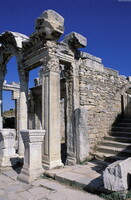| dc.coverage.spatial | Site: Ephesus, Aegean Region, Turkey | en_US |
| dc.coverage.temporal | ca. 128-138 (creation) | en_US |
| dc.creator | unknown (Ancient Roman) | en_US |
| dc.date | 128-138 | en_US |
| dc.date.accessioned | 2013-02-26T21:15:53Z | |
| dc.date.available | 2013-02-26T21:15:53Z | |
| dc.date.issued | 128-138 | en_US |
| dc.identifier | 196510 | en_US |
| dc.identifier.other | archrefid: 1570 | en_US |
| dc.identifier.uri | http://hdl.handle.net/1721.3/104018 | |
| dc.description | View of the side elevation; [The Temple of Hadrian dates from the 2nd century but underwent repairs in the 4th century and has been re-erected from the surviving architectural fragments. The reliefs in the upper sections are casts, the originals now in the Selçuk Archaeological Museum. A number of figures are depicted in the reliefs, including the emperor Theodisius I with his wife and eldest son.] "Three Corinthian temples date from the 2nd century AD: that of Hadrian, originally built for Trajan, with a Syrian arch and a figural frieze partly added in Late Antiquity; the Serapeion, and a large peripteral structure on the harbour plain. A high point in Roman architectural ornament was reached in the Hadrianic period in the Temple of Hadrian and the Library of Celsus. Here the whole repertory of contemporary ornament appears: strigilation, fish-scale pattern, vegetal and animal motifs. Column capitals also demonstrate a development from the pure Corinthian form to the more elaborate Composite order found in the Trajanic period at the Nymphaeum of Trajan." Source: Grove Art Online; http://www.oxfordartonline.com/ (accessed 7/13/2008) | en_US |
| dc.format.medium | stone | en_US |
| dc.rights | © Scott Gilchrist, Archivision, Inc. | en_US |
| dc.subject | architectural exteriors | en_US |
| dc.subject | rulers and leaders | en_US |
| dc.subject | Roman Empire | en_US |
| dc.subject | Corinthian | en_US |
| dc.subject | Hadrianic | en_US |
| dc.subject | Imperial (Roman) | en_US |
| dc.title | Temple of Hadrian | en_US |
| dc.title.alternative | Ephesus: Temple of Hadrian | en_US |
| dc.type | image | en_US |
| dc.rights.access | Licensed for educational and research use by the MIT community only | en_US |
| dc.identifier.vendorcode | 1A3-R-T-E-4-A3 | en_US |
| vra.culturalContext | Ancient Roman | en_US |
| vra.technique | construction (assembling) carving (processes) | en_US |
| vra.worktype | temple | en_US |
| vra.worktype | excavation (site) | en_US |
| dc.contributor.display | unknown (Ancient Roman) | en_US |



